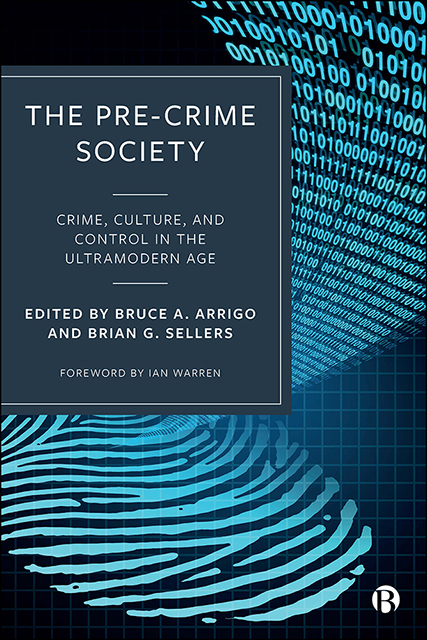Book contents
- Frontmatter
- Dedication
- Contents
- Notes on Contributors
- Foreword
- Introduction: The Ultramodern Age of Criminology, Control Societies and ‘Dividual’ Justice Policy
- Part I Theories, Theorists and Theoretical Perspectives
- Part II Institutions, Organizations and the Surveillance Industrial Complex
- Part III Dataveillance, Governance and Policing Control Societies
- Part IV Systems of Surveillance, Discipline and the New Penology
- Part V Globalizing Surveillance, Human Rights and (In)Security
- Afterword: ‘Pre-Crime’ Technologies and the Myth of Race Neutrality
- Index
1 - The ‘Risk’ Society Thesis and the Culture(s) of Crime Control
Published online by Cambridge University Press: 14 April 2023
- Frontmatter
- Dedication
- Contents
- Notes on Contributors
- Foreword
- Introduction: The Ultramodern Age of Criminology, Control Societies and ‘Dividual’ Justice Policy
- Part I Theories, Theorists and Theoretical Perspectives
- Part II Institutions, Organizations and the Surveillance Industrial Complex
- Part III Dataveillance, Governance and Policing Control Societies
- Part IV Systems of Surveillance, Discipline and the New Penology
- Part V Globalizing Surveillance, Human Rights and (In)Security
- Afterword: ‘Pre-Crime’ Technologies and the Myth of Race Neutrality
- Index
Summary
Introduction
It is or contention that this book, The Pre-Crime Society: Crime, Culture and Control in the Ultramodern Age, furthers a project that was initiated and subsequently developed within two of our previous volumes (Arrigo & Milovanovic, 2009; Arrigo, Bersot & Sellers, 2011). Among the themes shared by these volumes was a sustained focus on the philosophical currents and cultural intensities that produce de-vitalizing and finalizing laws of shared human captivity (Arrigo & Sellers, 2018). These laws originate in the captivity of forms (Plato, 2008), including the forms of human abstraction and their sequelae (Arrigo & Polizzi, 2018).
In the first of these volumes, Bruce Arrigo and Dragan Milovanovic (2009) argued for a ‘revolution in penology’ (pp. 3–8). As the authors explained, this revolution begins with a radical critique of subjectivity (i.e. human capital abstracted) and the constitutive forces into and out of which this subjectivity both shapes and is shaped by a ‘society of captives’ (pp. 170–95). This is the captivity of the kept and their keepers, the watched and their watchers in which risk-as-currency prevails as trade. The authors further asserted that when the excesses of this captivity are maintained in consciousness, through dialogical encounters, and in material expressions of the same, then they (these excesses) nurture the captivity of society. This is the captivity of ontology (i.e. of being human), and of epistemology (i.e. of human relating). The maintenance of these conditions forestalls a ‘people yet to come’ (Deleuze & Guattari, 1994, p. 108), and forecloses what Hardt and Negri (2004) have described as the ‘multitude’ (pp. 97–157).
The ubiquity of the prison form is revealing of captivity, both as meditation on and metaphor about risk, the risk of being human and of evolving in humanness (Nietzsche, 1966), amidst the culture of crime control that the management of human risk inevitably spawns (e.g. Ericson & Haggerty, 1997; O’Malley, 2004). By prison form we mean its symbols and discourses (Sloop, 1996; Brown, 2009), its architecture and environmental designs (Johnston, 2006; Day, 2013; Reiter and Koenig, 2015), its industries and mechanisms (Alexander, 2011; Geunther, 2013). In this regard, we might think of the prison form as what Foucault (1980) described as a dispositif: an apparatus of discipline and of disciplining whose systems of thought reproduce a network of discursively structured power/knowledge relations (pp. 194–228).
- Type
- Chapter
- Information
- The Pre-Crime SocietyCrime, Culture and Control in the Ultramodern Age, pp. 17 - 42Publisher: Bristol University PressPrint publication year: 2021

